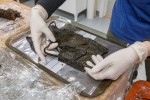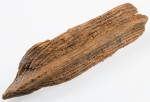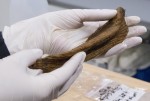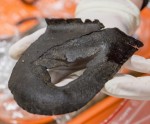 Archaeologists have discovered a well preserved toy boat carved 1,000 years ago on the peninsula of Ørland about 60 miles northwest of Trondheim, Norway. Ørland today is a peninsula of some girth, but during the Iron Age it was skinny and curved downwards, creating a sheltered bay on the south side. The land has risen up in the centuries since then, and today that bay is on terra firma more than a mile from the coast. That land is slated to be used for an expansion of the Ørland Main Air Base. Before construction could begin, the site had to be extensively explored by archaeologists from the Norwegian University of Science and Technology (NTNU) University Museum in Trondheim.
Archaeologists have discovered a well preserved toy boat carved 1,000 years ago on the peninsula of Ørland about 60 miles northwest of Trondheim, Norway. Ørland today is a peninsula of some girth, but during the Iron Age it was skinny and curved downwards, creating a sheltered bay on the south side. The land has risen up in the centuries since then, and today that bay is on terra firma more than a mile from the coast. That land is slated to be used for an expansion of the Ørland Main Air Base. Before construction could begin, the site had to be extensively explored by archaeologists from the Norwegian University of Science and Technology (NTNU) University Museum in Trondheim.
 The NTNU University Museum has been excavating the site every year since 2014. In three seasons of fieldwork, the team has excavated a vast area of almost 120,000 square meters (1,292,000 square feet). It is by far the largest archaeological dig the museum has ever undertaken. So ambitious a scope was necessary because Ørland had been inhabited for thousands of years. Its fertile land and strategic location at the mouth of Trondheim Fjord made it an ideal spot for farmers and traders alike.
The NTNU University Museum has been excavating the site every year since 2014. In three seasons of fieldwork, the team has excavated a vast area of almost 120,000 square meters (1,292,000 square feet). It is by far the largest archaeological dig the museum has ever undertaken. So ambitious a scope was necessary because Ørland had been inhabited for thousands of years. Its fertile land and strategic location at the mouth of Trondheim Fjord made it an ideal spot for farmers and traders alike.
 Archaeologists have unearthed evidence of seven farms having occupied the land over the course of the 1,500 years from 500 B.C. to 1000 A.D., a unique temporal cross-section that will give researchers new insight into how farming communities in the area evolved. Remains found include postholes for houses and fences, the ever-valuable garbage middens, cooking pits and wells.
Archaeologists have unearthed evidence of seven farms having occupied the land over the course of the 1,500 years from 500 B.C. to 1000 A.D., a unique temporal cross-section that will give researchers new insight into how farming communities in the area evolved. Remains found include postholes for houses and fences, the ever-valuable garbage middens, cooking pits and wells.
 Two of those wells yielded exceptional organic artifacts. Filled with dirt centuries ago and then waterlogged by the high water table of land that not so long before had been a bay, the wells proved adept at preserving objects that otherwise would have rotted away centuries ago. In one well archaeologists found a wooden toy boat. In a second well they found pieces of leather from shoes and one shoe that was almost intact. At first archaeologists though the leather shoes and boat must date to early modern times at the earliest, but radiocarbon dating revealed that the artifacts dated to the reign of Olav den Hellige, ling of Norway from 1015 to 1028.
Two of those wells yielded exceptional organic artifacts. Filled with dirt centuries ago and then waterlogged by the high water table of land that not so long before had been a bay, the wells proved adept at preserving objects that otherwise would have rotted away centuries ago. In one well archaeologists found a wooden toy boat. In a second well they found pieces of leather from shoes and one shoe that was almost intact. At first archaeologists though the leather shoes and boat must date to early modern times at the earliest, but radiocarbon dating revealed that the artifacts dated to the reign of Olav den Hellige, ling of Norway from 1015 to 1028.
 The toy boat is carved with care. It has a raised prow and a hole in the middle where a mast with a sail could be inserted.
The toy boat is carved with care. It has a raised prow and a hole in the middle where a mast with a sail could be inserted.
“This toy boat says something about the people who lived here,” said Ulf Fransson, an archaeologist at the NTNU University Museum and one of two field leaders for the Ørland Main Air Station dig, where the well and the boat were found.
“First of all, it is not so very common that you find something that probably had to do with a child. But it also shows that the children at this farm could play, that they had permission to do something other than work in the fields or help around the farm.”
 That may seem a little on the obvious side — that a farmer’s child might have a homemade toy to play with seems more plausible to me than a farm where the children are only allowed to work day and night — but the notion of leisure time varies over time, social class and geography. A toy boat from this period has been found in Trondheim, for instance, but that was more expected because Trondheim was the capital of Norway then and a major center of trade, so it had a concentration of people with disposable income could afford to give their children cool toys and the free time to play with them.
That may seem a little on the obvious side — that a farmer’s child might have a homemade toy to play with seems more plausible to me than a farm where the children are only allowed to work day and night — but the notion of leisure time varies over time, social class and geography. A toy boat from this period has been found in Trondheim, for instance, but that was more expected because Trondheim was the capital of Norway then and a major center of trade, so it had a concentration of people with disposable income could afford to give their children cool toys and the free time to play with them.
The find from Ørland, however, is very different, says Ingrid Ystgaard, an archaeologist who is head of the entire Ørland Main Air Base project.
“The Middle Age farm here is far from the sea, it is not that strategically located,” she said. “There are other farms in Ørland that were better located.”
Thus, this medieval farm was probably not the richest farm in the area, far from it. Yet life here was good enough so that someone had time to carve the toy boat for a child. And the child had time to play with it.
 The shoes and fragments found in the other well also suggest that the inhabitants of the farm trod the line between frugality and some measure of comfort.
The shoes and fragments found in the other well also suggest that the inhabitants of the farm trod the line between frugality and some measure of comfort.
“These were more of an ordinary shoe, a work shoe that they wore every day,” Fransson said. One of the shoe pieces that was found was a heel piece from a large sole, with a hole worn through it. The clean-cut front edge of the heel piece shows that “the shoe was worn out and they did repair it,” he said.
But because the researchers found much of a whole shoe, “that tells me that they weren’t that poor either, because they had the means to throw (a whole shoe) out,” he said.
 The excavations are now complete, but the research will continue for years. Archaeologists have a great many samples collected from the middens, cooking pits and postholes, plus they have core samples taken from a neighboring wetland. The middens and pits are replete with bones from land animals, fish and shellfish, which will provide more information about the local diet. The posthole soil samples include pollen, seeds, grains so we can found out what kind of crops they raised or ate. The pollen in the core samples will provide a vegetation map of the area over the last 2,500 years.
The excavations are now complete, but the research will continue for years. Archaeologists have a great many samples collected from the middens, cooking pits and postholes, plus they have core samples taken from a neighboring wetland. The middens and pits are replete with bones from land animals, fish and shellfish, which will provide more information about the local diet. The posthole soil samples include pollen, seeds, grains so we can found out what kind of crops they raised or ate. The pollen in the core samples will provide a vegetation map of the area over the last 2,500 years.
[youtube=https://youtu.be/B_S36zeqXpM&w=430]